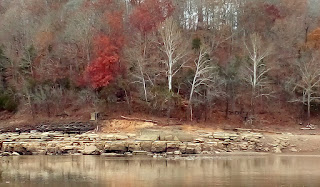About a 30 minute drive from my home thru small country towns, down winding country roads that flow through, around, and over the rolling hills of south central Kentucky, is Barren River Lake. It's a gem of a lake characterized by clear waters, rocky bluffs, thick woodlands, and scenery that can often be overlooked if care is not taken to avoid doing so. As a photographer, my eye is always searching for a special moment of light, and too often I too have been found guilty of overlooking this wonderful location.
Today I made a special attempt to remedy that verdict. I drove over to Brown's Ford with the idea of dropping my canoe into the water and working my way to the tail end of the lake, about 2 miles, where Barren River and Long Creek converge. The particular spot offers a wonderful peninsula that separates the two water systems.
I wanted to work my way up Barren River as far as I could manage using a trolling motor to do most of the heavy work, to search for a campsite along the river bank for a potential canoe camping, photography outing sometime in the future.
 |
| Taken summer 2021 |
The previous summer I managed to do some fishing in that area with some photography tossed in. Along with catching a few nice bass, I captured a couple of very nice images, one of a deer swimming across a gap between two small islands with misty fog hovering in the background, and another of reflections cast across a hidden inlet.
 |
| Taken summer 2021 |
Barren River Lake is maintained through the year by allowing the lake level to rise in summer and to drawn it down during the winter. On this outing, it was approaching its lowest winter pool level, about 20 feet or so lower than the summer level, and what was a wide expanse of flat water the previous summer was now a narrow band of shallow water with exposed rock and sandy banks. There was also a good current flowing at the boat ramp. My attempt at working my way to the confluence of Barren River and Long Creek was thwarted as the water levels were just too low to allow for a comfortable use of a trolling motor and the current was too strong to paddle against for that distance.
Instead I turned what was an ambitious outing into a simpler outing and took my time paddling around the boat ramp area working down to a long curving bluff to enjoy a short moment on the water. As I began to float that way, a Bald Eagle emerged from the tree line to my right and flew across the gap separating the long bluff from the bluff nearest to Browns Ford. He glided with a graceful soar, barely working his wings, the white of his head and tail standing out boldly against the gray background. Then, he pulled his massive wings back in a slow motion arch, almost stopping in mid air to land on a high limb overlooking the channel.
I had no camera this time except for my cell phone and it was still packed away, so I just drifted toward my Eagle friend and came to within about 20 yards of him before he launched himself into the air. I followed his white head and tail as he flew along the long, curving bluff, to finally drift out of sight some distance away. Not a single photo I made of this magnificent bird, but the memory of the moment will last me forever.
For the next hour or so, I simply paddled around, briefly talking to an elderly fellow fishing off the bank, and I managed with my phone to snap a photo or two of the scenic point anchoring the long bluff. I'm guessing the trees with the white trunks are Sycamore trees, and the tree with the reddish leaves are beech trees with their fall season remnant allotment of dried but not yet dropped leaves.As I made my way back to the boat ramp against the current, a couple hundred gulls circled around, squawking as they do, to eventually land on the other side of a sandy mound.
I beached the canoe and made my way over to where they were and managed to take a few photo's using my phone along with a short video clip. They are graceful fliers after all.
The day afield came to an end shortly after my gull encounter. I loaded all my gear back into and on top of my Jeep, always a sad moment. As it turned out, the outing fell well short of what I was wanting to do, but in the end, seeing the Bald Eagle and watching the gulls was reward enough. Just being out and feeling the canoe under me again, well...it was a simple outing, but one well worth the effort.


















































